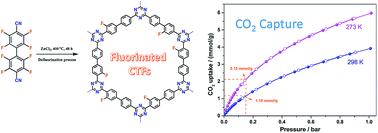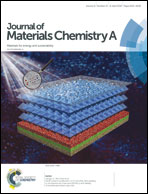A fluorine-containing hydrophobic covalent triazine framework with excellent selective CO2 capture performance†
Abstract
In this article, a set of fluorine functionalized covalent triazine-based frameworks have been designed and synthesized with 2,2′,3,3′,5,5′,6,6′-octafluoro-4,4′-biphenyldicarbonitrile as the monomer under typical ionothermal conditions. A prominent defluorination process during synthesis etches the networks to release CFn, resulting in a significant loss of fluorine and carbon. Notably, the synergistic effects of polar C–F bonds and rich CO2-philic N sites bestow upon the framework an excellent H2 uptake (1.77 wt%, 77 K and 1 bar) as well as a significantly high CO2 adsorption capacity (5.98 mmol g−1, at 273 K and 1 bar), surpassing all related CTF materials measured under identical conditions that have been reported in the literature to date. Additionally, the material also exhibits a high CO2/N2 selectivity of 31 as predicted by the Henry model. The hydrophobicity of the CTF materials has been significantly enhanced owing to the incorporation of hydrophobic fluorine groups, which was further confirmed by ambient water vapor sorption.



 Please wait while we load your content...
Please wait while we load your content...